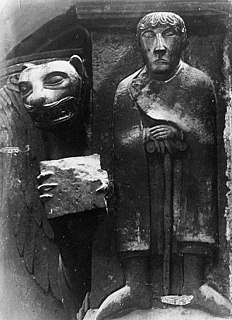Related Research Articles

The Abbey Church of Saint Peter and Saint Paul, Shrewsbury is an ancient foundation in Shrewsbury, the county town of Shropshire, England.

Bec Abbey, formally the Abbey of Our Lady of Bec, is a Benedictine monastic foundation in the Eure département, in the Bec valley midway between the cities of Rouen and Bernay. It is located in Le Bec Hellouin, Normandy, France, and was the most influential abbey of the 12th-century Anglo-Norman kingdom.

Richard II, called the Good, was the duke of Normandy from 996 until 1026.
The Antiphonary tonary missal of St. Benigne was written in the last years of the 10th century, when the Abbot William of Volpiano at St. Benignus of Dijon reformed the liturgy of several monasteries in Burgundy. The chant manuscript records mainly Western plainchant of the Roman-Frankish proper mass and part of the chant sung during the matins, but unlike the common form of the Gradual and of the Antiphonary, William organized his manuscript according to the chant genre, and these sections were subdivided into eight parts according to the octoechos. This disposition followed the order of a tonary, but William of Volpiano wrote not only the incipits of the classified chant, he wrote the complete chant text with the music in central French neumes which were still written in campo aperto, and added a second alphabetic notation of his own invention for the melodic structure of the codified chant.
Gilbert Crispin was a Christian author and Anglo-Norman monk, appointed by Archbishop Lanfranc in 1085 to be the abbot, proctor and servant of Westminster Abbey, England. Gilbert became the third Norman Abbot of Westminster to be appointed after the Norman Conquest, succeeding Abbot Vitalis of Bernay.

Saint William of Volpiano also of Dijon, of Saint-Benignus, or of Fécamp was a Northern Italian monastic reformer, composer, and founding abbot of numerous abbeys in Burgundy, Italy and Normandy.
Robert de Grantmesnil also known as Robert II, was a Norman nobleman; a member of a prominent Norman family. He first became a monk, then abbot at the Abbey of Saint-Evroul in Normandy and later Bishop of Troina in the Norman Kingdom of Sicily.
John Flete was an English monk and ecclesiastical historian who documented the history and abbots of Westminster Abbey.
John of Fécamp, was an Italian-Norman Benedictine who was the most widely read of early medieval spiritual writers before the Imitation of Christ became popular, during a period called the Golden Age of Monasticism and of Scholasticism, and the height of the Papacy. Writing under the name of famous writers, he wrote the very popular book Meditations of St. Augustine and the book Meditations. He was born near Ravenna and died at Fécamp Normandy, as the Abbot of the Abbey of Fécamp. He was nicknamed 'Jeannelin' or 'Little John' on account of his diminutive stature.

Judith of Brittany, also called Judith of Rennes (982–1017), was Duchess of Normandy from c. 1000 until her death.
Anselm was a medieval bishop of London whose election was quashed by Pope Innocent II. He was a monk of Chiusa, abbot of Saint Saba in Rome, papal legate to England, and abbot of Bury St Edmunds.
The Abbey of Saint-Evroul or Saint-Evroul-sur-Ouche is a former Benedictine abbey in Normandy, located in the present commune of Saint-Evroult-Notre-Dame-du-Bois, Orne, Normandy. Its name refers to its founder, Ebrulf (Evroul), who founded a hermitage in the forest of Ouche around 560. The abbey was rebuilt around 1000.

The Abbey of the Holy Trinity at Fécamp, commonly known as Fécamp Abbey, is a Benedictine abbey in Fécamp, Seine-Maritime, Upper Normandy, France.
Humphrey de Vieilles was the first holder of the "grand honneur" of Beaumont-le-Roger, one of the most important groups of domains in eastern Normandy and the founder of the House of Beaumont. He was married to Albreda or Alberée de la Haye Auberie.
Sulcard was a Benedictine monk at St. Peter's, Westminster Abbey, and the author of the first history of the abbey.
Richard of Ware was the abbot of Westminster Abbey from 1258 to 1283.
Hugh was a French knight and Benedictine monk, abbot of monasteries in England and France.

Bernay Abbey was a Benedictine abbey in Bernay, Eure, France. The designers of its abbey church were ahead of their time, making it one of the first examples of Romanesque architecture in Normandy. It shows the early evolution of that style, its decorative elements and its building techniques.

Saint-Gabriel-Brécy Priory was a Benedictine priory 10 km from the coast between Caen and Bayeux. It is sited in the town of Saint-Gabriel-Brécy, Calvados, France. A 13th century gate-tower survives, with ogive vaulting on sculpted capitals. It was adjoined by a now-lost guesthouse. The cornice is sculpted with small three-point arches. The vaulted refectory dates to the late 13th century. A keep was built to serve as a prison in the 15th century, whilst the Renaissance-style courtroom was built towards the end of the 16th century. A dovecote is now lost.

Nicolas of Normandy was the fourth abbot of Saint-Ouen Abbey, Rouen.
References
- ↑ Emma Mason, Westminster Abbey and Its People, C.1050-c.1216, 1996, pages 23 to 25
- ↑ Orderic Vitalis, Ecclesiastical History, Book III, ii., 116
- ↑ "Abbot Vitalis".